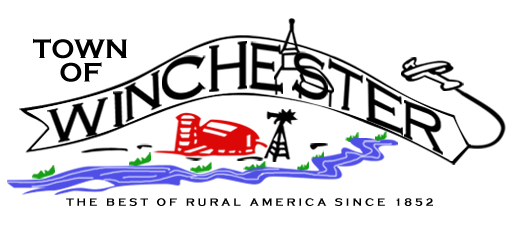Where is Winchester?
The Town of Winchester is located in northwest Winnebago County, Wisconsin. The Town enjoys a blend of family farming operations and residential development. In total, the township includes approximately 36 square miles and is home to about 1,700 people. The Town of Winchester shares borders with: Outagamie County, the Town of Wolf River, the Town of Winneconne, and the Town of Clayton.
How did Winchester get its name?
It is not known how the name 'Winchester' was selected. The Town is not named for the famous Winchester rifle because it did not make its appearance until several years after the township was formed. It is also unlikely that the Town is named after some person or family because no person with the surname Winchester has ever lived in the township.
In an interview with Hazel Kevill, who was born and raised in Winchester, she indicated 'It was named after a Winchester in England.' Hazel was a descendent of an old 'Yankee' family, but unlike most of the Yankees, her family emigrated directly from England to Wisconsin. There were a number of so-called Yankee families that had come directly to the United States just about the time the Town was established.
The city of Winchester in southern England has had an important role in English history. There are associations with the legendary King Arthur and his knights of the Round Table. There is also a famous cathedral, as well as, a famous prep school for boys called Winchester College.
When settlers came to the New World, it is not surprising that they would choose names from their homeland. There are Winchesters in 19 states. Wisconsin is blessed with two Winchesters - our Winchester in Winnebago County and another in Vilas County, much to the confusion of postal workers and others.
It is also entirely possible that Winchester could have been named after a town by that name in one of the eastern states from which some of the early settlers came.
How was Winchester settled?
The area that was to become Winchester Township was originally occupied by bands of Indians belonging to various tribes. The two tribes living in Winnebago County were the Menomonees and the Winnebagos. The Menomonees had claimed and held all the land in Winnebago County, while the Winnebagos only lived in this area by permission. For the privilege of living in this area the Winnebagos "paid an annual tribute to the Menomonees, consisting of corn, potatoes and dried pumpkins.
In 1835, near the end of the period of Indian ownership, the first commercial logging took place in the area. Logs were cut along the Rat River by men in the employ of Daniel Whitney, of Green Bay. On September 3, 1836, Henry Dodge, the territorial governor, and the Menomonee Indians, signed the Treaty of Cedar Point. According to this treaty the Menomonees agreed to give up their lands north of the Fox River and east of the Wolf River. The treaty would eventually open up northern Winnebago County, including the future Town of Winchester, to settlement. Although the treaty was signed in 1836, it was several years before the land became available for sale at the government land offices in Green Bay. First the land had to be surveyed. At that time, the area that would become later Winchester Township was given the following designation for map surveying purposes - Township 20N (North) Range 15E (East). When the land in Township 20N Range 15E was made available for purchase, the price was $1.25 per acre.
The first settlers began to arrive in 1848 - the same year that Wisconsin became a state. Over the next several years families which had recently (i.e. in the last several years) come from Europe and families whose immigrant ancestors arrived in America many years earlier began to claim parcels of land within Winchester. Probably the largest groups of settlers were Norwegians, some of whom had just immigrated to America and some whose families may have come to America as early as 1839 or the early 1840's. Besides the Norwegians, some of the first settlers in this area came from the East Coast region or were recent immigrants from Wales.
Within a few years, German settlers arrived. Most, if not all, of the German settlers purchased parcels of land in the western portion of the township, as the Norwegians and others had already claimed most of the eastern portion of the Town.

